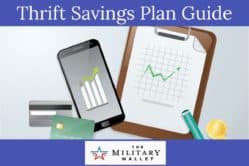You can take a loan from your Thrift Savings Plan (TSP) account for general use purposes or buy a new or existing primary residence. Low interest rates and a fairly easy application process make TSP loans an attractive alternative to other loans.
However, several things are good to know before you apply.
What is a TSP Loan and How Does it Work?
You’re borrowing from your savings with a TSP loan, so qualifying for a TSP loan is typically easy. No qualification document is usually required for a general purpose loan.
Still, you must supply several pieces of documentation if you want to use the loan to buy a home. Depending on the loan you choose, you’ll have up to 15 years to repay the loan with a fixed interest rate.
As a service member or federal civilian employee, payments can automatically withdrawn from your paycheck.
You can apply for a loan by logging into your TSP account and following the instructions on the TSP site.
The minimum you can borrow is $1,000, but the maximum amount is based on how much money is in your account. In general, you can borrow up to 50% of your account up to a maximum of $50,000 for a general purpose loan.
You have up to five years to pay back a general purpose loan and up to 15 years for a residential purchase loan, providing you with a good degree of payment flexibility.
You’ll also want to ensure you can repay the monthly TSP loan payments. Use the Thrift Savings Plan loan payments calculator to determine how much you can expect to pay each month.
One thing to consider is that when you take a loan out against your TSP account, your retirement amount may grow more slowly since you don’t have as many funds to invest because they are tied up in a loan.
With a TSP loan, you are essentially borrowing your own money within a specified period to pay it back. The TSP loan rate charged will be equivalent to the TSP G Fund rate the month before you requested the loan.
Much like a 401(k) loan, when you pay interest charges on a TSP loan, you’re paying them to yourself instead of to a bank or lending institution because all the money repaid goes back into your retirement account.
Two Types of TSP Loans
There are two types of TSP loans.
Residential TSP Loan
A residential TSP loan is limited to use to purchase your primary residence. As part of the documentation process, you must provide all pages of the signed sales agreement, purchase contract, or settlement offer.
If you’re building a new residence, you need to provide a signed copy of the builder’s contract or building permits if you are building the home yourself.
The repayment period is 5 to 15 years, and the processing fee is $100.
General Purpose TSP Loan
As the name implies, you can take out a loan for any purpose, from buying a car to paying off debt or any other use of the funds you want to borrow. This loan requires no documentation.
You can select to pay it back between 1-5 years, and the processing fee is only $50.
You can take out a general purpose and a residential purchase loan at the same time, but you can only have one active loan per loan type. You can get around this with civilian and military service TSP accounts.
The limit on the amount you can borrow is the same for both types of loans. The minimum loan amount is $1,000, and the maximum loan amount is limited to the lowest amount based on several factors, including:
- Your contribution and earnings, less any outstanding loan balance
- 50% of your account balance based on contributions and earnings or $10,000, whichever is greater after it’s been offset by any outstanding loan balance
- $50,000 minus your highest outstanding loan balance within the last 12 months. Even if the loan has been paid, the balance would still be used if it was open within the previous 12 months.
Who Can Take Out a TSP Loan?
You must be a uniformed service member or a federal employee for both TSP loan types.
Other requirements include:
- A minimum of $1,000 of your own contributions in your TSP account.
- Not have repaid a TSP loan of any type in the past 30 business days.
- Be in “active pay” status because TSP loan repayments will be deducted from your paycheck.
- Not having had a taxable distribution on a loan within the past 12 months unless it is related to your separation from federal service.
- Only one general purpose TSP loan and one residential TSP loan per account can be used at any time.
- Not have a court order placed against your TSP account.
- No documentation is required for a general purpose loan, but you must supply several types of paperwork for a residential home loan, including proof of employment, a demonstration of the intended use of funds, and other documentation required by the TSP.
How to Apply for a TSP Loan
Applying for a general purpose TSP loan is easy. Log into “My Account” on the TSP site to start the process. You may be able to complete the entire process in a matter of minutes going this route.
You must have at least $1000 of your own contributions and earnings in the account to borrow money. You can not borrow from agency contributions or earnings, and the maximum amount of money you can borrow is $50,000.
For a residential home loan, the process is more complicated because you will need to gather and submit documentation to support your ability to pay back the loan.
If you prefer, you can also use ThriftLine Service options, such as phone, fax, or mail.
For both loans, you must be currently employed as a federal civilian employee or a member of the uniformed services. Retired and separated individuals are not eligible for a loan.
You must also be in pay status because loan repayments are deducted directly from your paycheck. Additionally, you must not have repaid a previous loan of the same type in full within a 60-day period.
Meeting the repayment schedule of a TSP loan is not merely a contractual obligation but also a critical step in safeguarding your financial future. Regular repayments, typically deducted directly from your paycheck, ensure the steady replenishment of your retirement fund.
Delays or defaults on repayments can incur penalties and tax liabilities, potentially affecting your credit score.
Finally, you can still borrow from your Thrift Savings Plan account even if you have stopped making contributions with your own money.
Pros and Cons of TSP Loans
The Pros
- Low interest rates are tied to the current TSP G Fund rate when the loan is issued. Currently hovering just above 4%, this is a more favorable rate than most other types of personal loans.
- No credit checks for general purpose loans because you’re borrowing your own money.
- TSP general purpose loans are flexible, with funds that can be used for any purpose.
- No prepayment penalties.
- Low processing fees of $50 for a general purpose loan and $100 for a residential home loan.
- Interest payments are returned to you. The interest you pay is deposited back into your TSP account. Even though you’ll be paying interest back to yourself, that amount is often less than what you would have earned if the money had remained in your TSP account.
The Cons
- Because you’re using a portion of your TSP contributions as a loan, that money is no longer benefitting from investment growth. As a result, your TSP account will not grow as quickly.
- There is a cap on borrowing based on a percentage of your contributions and earnings, typically capped at $50,000.
- Assuming the loan comes out of the Traditional TSP, it is tax deferred and taxable at retirement distributions. You are paying for the TSP loan & interest using after-tax dollars from your paycheck. While the original loan balance was not taxed, the interest you are paying will face double taxation.
- If your loan becomes delinquent, the entire loan will be treated as taxable income, and you may also need to pay a 10% early withdrawal tax penalty if you are under age 59 ½.
- Since you are borrowing from yourself, TSP loans do not help you build or improve your credit because payments are not reported to credit bureaus.
- If you leave your federal job with an outstanding loan balance, you can keep paying the loan monthly, pay it off by the set deadline, or let it be foreclosed in 90 days and take on the remaining debt as taxable income.
Frequently Asked Questions About TSP Loans
Can you take out more than one TSP loan at a time?
You can have two loans outstanding at any time from your TSP account, but only one can be a primary residence loan. The other restriction on the number of loans outstanding is that you can’t take out a new loan within 60 days of paying off an existing loan from your account.
What are some reasons you can be denied a TSP loan?
If you have defaulted on a previous TSP loan, have a low balance in your account, or don’t meet other approval criteria, you could be denied. Approval is fairly easy but not automatic.
Is a TSP loan the same as a hardship withdrawal?
No. A loan requires you to repay the money you borrowed. A TSP Hardship Withdrawal does not. However, you will have to pay any associated taxes, penalties, and fees for early withdrawals.
Does a TSP loan affect your credit?
A TSP loan does not appear on your credit report because you are borrowing your own money, meaning the only person you owe it back to is yourself.
How long does it take to get funded with a TSP loan?
You’ll usually get the money within three business days when you apply and are approved online. Paper applications submitted by mail take up to several weeks to process.
What happens to my loan when I separate from service or retire?
When you separate or retire from federal service with a loan balance, you must set up a payment plan or pay off the loan balance. If you don’t do either, the loan is considered in default, and the full loan balance would be taxable as income in that same year.
If you’re under 59 1/2, you would also pay the 10% tax penalty on top of income tax. The TSP will work with you to set up payments, but it is your responsibility to ensure the payment amount is correct and timely.
Conclusion
Thrift Savings Plan loans and 401k loans are available if you need access to your money, but there are risks involved. It is best to seek alternatives before withdrawing funds from your retirement account.




Comments:
About the comments on this site:
These responses are not provided or commissioned by the bank advertiser. Responses have not been reviewed, approved or otherwise endorsed by the bank advertiser. It is not the bank advertiser’s responsibility to ensure all posts and/or questions are answered.
Claire says
I took a $20,000 loan out against my TSP. I have been making regular payments just fine. I plan to transfer Guard to Reserve. I learned (by calling a TSP agent) that they will get a code saying I am no longer in the military and it will be up to me to pay back the loan. If this is true, will they allow me to continue to make payments? I will not be able to make the payment in one lump sum.
Also…when I am officially in the Reserves (there will be no break in service but I am technically discharged then immediately back in), can I let TSP know and go back to the way it was before? Paying monthly?
Maybe there is no disruption at all and TSP will never know? The agent said that DFAS may not send that “code”. I can’t get ahold of DFAS so I was hoping that someone had the answer.
Ryan Guina says
Hello Claire, I don’t have an answer for you. I recommend contacting DFAS again during their customer service answers. You can also try getting something in writing from either DFAS or the TSP.
Those are the best organizations to answer this question.
I wish you the best, and thank you for your service!
Dawn says
I need advice. I have worked for the Gov for 10 years. I contributed the max for most of that time. My current situation includes 10000 worth up debt from credit cards, school loans, etc. I have been trying to pay them off for a while now. It is creating a hardship after a divorce and going to one income. If I took a withdrawal of 10000 from TSP to wipe my slate clean, would this be smart?? I don’t want debt. I’m also on the AF reserves. Any advice, please???
Micah says
To borrow money from my TSP account, I can only borrow what I have correct? I have only contributed 6K into my TSP at this point, so that is all I am able to borrow?
Ryan Guina says
Jennifer, I would try to avoid TSP loans because they can prove to be more expensive in the long run, especially if you leave government service before the loan is repaid, which could cause the loan to be due in full, or it would be counted as a distribution, leading to an immediate 10% early withdrawal penalty.
If it were me, I would look into getting a personal loan from a company such as Lending Club or Prosper. These companies facilitate Peer to Peer Loans, which lets regular people loan money to other people. You can often find better rates than you can through a bank.
That said, only you can make the final decision. I recommend checking out different options and weighing making the decision based on which is best for your specific situation.
Jennifer Lee says
So if you were trying to decide between a personal loan at 12% interest versus a TSP loan, what would be the smarter thing to do?
Ryan Guina says
Aron, I think you may be misunderstanding how TSP contributions work – the government isn’t giving anyone free money (with the exception of matching contributions, which are presently are not available to military members).
Contributions to the Thrift Savings Plan are tax deferred, meaning you don’t pay taxes on contributions when you make them. That gives you an immediate tax savings and you pay taxes on the money you make a qualified withdrawal in retirement age. So if you earn $10,000 and contribute $2,000, your paycheck is taxed as though you only earned $8,000. You would pay taxes on the $2,000 when you make a qualified withdrawal in retirement age. But there is no free money.
When you take out a TSP loan, you repay it with money that has already been taxed. Let’s look at your example of making $10,000 in contributions, then withdrawing that same amount as a loan.
The initial $10,000 was not taxed when it was contributed, and you will receive the full $10,000 as a loan. But when you repay your loan, you have to pay it back with money that has already been taxed. If you are in he 20% tax bracket, that means you will need to earn $12,500 to repay the $10,000 loan (assuming the 20% tax bracket you gave in your example; $10,000 is 80% of $12,500).
So you it will cost you $2,500 in taxes to be able to earn enough to repay your initial contribution. Then you get taxed on your withdrawals in retirement age, which can knock off another 20% or more in taxes. This is the double taxation I was referring to. There is a big disadvantage to being taxed twice.
Aron Rotklein says
I don’t understand the disadvantage of being taxed twice. Let’s pretend you put 10k into your TSP. If you are in the 20% bracket, you would have only received 8k of the 10k in your paycheck. Instead, the gov’t gave you a free 2k for the TSP account. Now you take out a 10k loan from your TSP. Of course you have to pay it back with after tax money. This does not negate the fact that the gov’t gave you a free 2k. When you take the money out at retirement, it is taxed just as if you never took a loan. The initial 2k tax advantage never disappeared.
reginald t barnes says
yes i would welcome all info from u ,and i do appreciate getting this information as often as u send them out